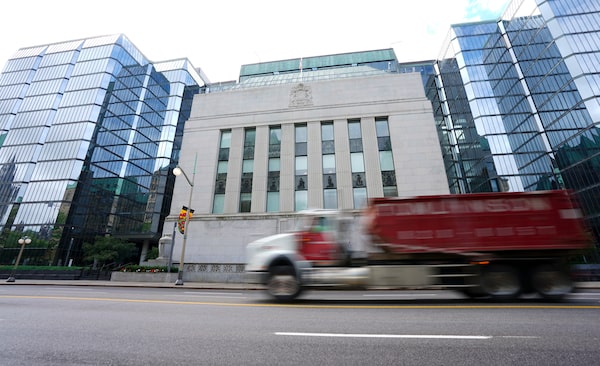
'There’s still a considerable amount of slack in the economy, and that will put downward pressure on inflation,' Bank of Canada Governor Tiff Macklem said in a news conference last week.Sean Kilpatrick/The Canadian Press
The Bank of Canada’s strongest argument against the current concerns of rising inflation is the big hole in employment left by COVID-19. But what if that hole suddenly filled in?
In the central bank’s quarterly economic and policy update last week, the bank argued that with the labour market about 550,000 jobs short of the prepandemic employment rate, and total hours worked 4-per-cent short of where they were before the first lockdowns, the Canadian economy is still a very long way from its full speed.
This is absolutely not a recipe for an inflationary build-up. The recent spike in the inflation rate is an unfortunate side effect rooted in the complicated nature of the reopening phase, but with all that unused labour supply sitting there, it can’t last.
“There’s still a considerable amount of slack in the economy, and that will put downward pressure on inflation,” Bank of Canada Governor Tiff Macklem said in a news conference last week.
The Bank of Canada’s flexibility on inflation is about to be put to the test
In a recovery from a normal recession, that much labour slack could take years to absorb. But this is an utterly unique recession in so many ways – not least of which is the wildly uneven impact on labour. Lockdowns and restrictions affected workers in some sectors deeply; in others, not at all.
As those hardest-hit sectors increasingly reopen, the missing jobs that they represent are poised to snap back in a way that would be impossible in a typical recovery.
In accommodation and food services alone, employment in June was down more than 260,000 from its prepandemic level. In information, culture and recreation, there’s another 70,000. These two sectors account for roughly half of the decline in hours worked from pre-COVID-19 levels.
Even if there are lingering restrictions and consumer hesitance that temper demand, the potential is there for a massive and rapid turnaround in the labour picture. Much of the apparent slack could be absorbed about as fast as those businesses can rehire.
It’s not as if jobs aren’t there. Statistics Canada reported more than 550,000 job vacancies in the first quarter of this year – one of the highest numbers on record – and survey data since then indicate that those numbers continued to grow over the spring. The Bank of Canada’s most recent Business Outlook Survey, conducted in May, showed the highest hiring intentions among employers in the survey’s 15-year history.
Mind you, there are some serious questions about how fast businesses can ramp up their staff, even those that have a pressing need, as customers come flooding back to their suddenly open doors. The reopenings to date have exposed the considerable complications involved in trying to meet an instant return of demand as pandemic restrictions are removed.
“It’s a lot easier to close an economy than it is to reopen one,” Mr. Macklem said. “Some companies are having trouble finding the workers they need, they’re having trouble finding the skills they need.”
“That’s going to take some time. But these are temporary adjustment issues as you reopen the economy,” he said.
As those temporary restart issues get resolved, we could see the slack in the labour market dry up incredibly quickly – driving up wage pressures at an unusual clip. The implication is that inflationary pressures could take less time than usual to build.
Still, if the Bank of Canada sounds a bit too cautious on the employment side, that could be offset somewhat by other areas of the economy on which its economic forecast may be a tad optimistic.
Stephen Brown, senior Canada economist for Capital Economics, argued in a research note Friday that the price of oil that’s baked into the Bank of Canada’s forecasts looks much too high. By convention, the bank doesn’t actually predict the price of oil, but rather takes the current price and uses that for all of its calculations. For the new forecasts, that means taking oil prices that are at three-year peaks, and putting those into the outlook.
Should the price retreat from those highs as the surge of reopening commodity demand fades, then the assumptions about export income, and energy-sector growth and investment, are all too high.
Mr. Brown also thinks the Bank of Canada has an unrealistically sunny outlook for the housing sector, which is already coming off its recent boil. The bank sees a moderation of residential investment, but expects it to settle at a higher pace than before the pandemic, fuelled by job growth and a recovery in immigration. Mr. Brown believes there’s a much bigger downside to housing than the Bank of Canada has bargained for.
None of this is really news to Mr. Macklem. He has cautioned – repeatedly – that forecasting economic growth and the path of inflation is unusually uncertain in this recovery. The bank will have to be ready to shift gears on its interest-rate policy in a hurry if inflation doesn’t evolve the way it expects – whether that’s fuelled by the job market or by some other factor.
“Of course there’s some uncertainty here. We don’t have a crystal ball,” Mr. Macklem said. “We will be watching the evolution of inflation very carefully.”
Your time is valuable. Have the Top Business Headlines newsletter conveniently delivered to your inbox in the morning or evening. Sign up today.
 David Parkinson
David Parkinson